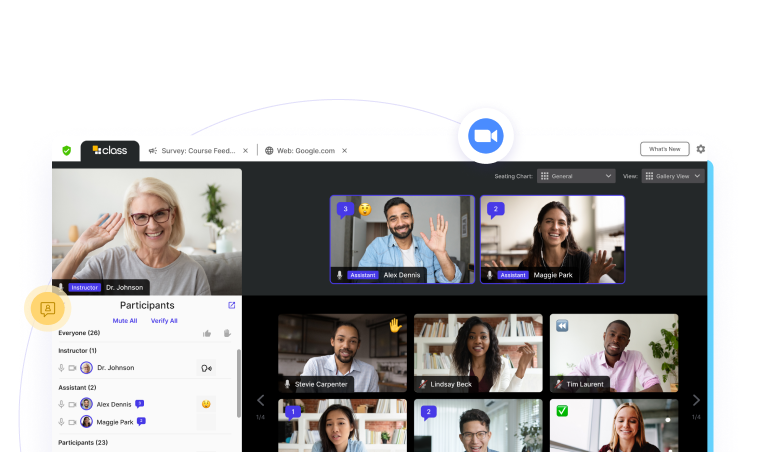
Mike Lovell is the SVP of Marketing at Class. He has dedicated his career to technology and the applications that can innovate the way people live and learn.

Mike Lovell is the SVP of Marketing at Class. He has dedicated his career to technology and the applications that can innovate the way people live and learn.

Virtual instructor-led training (VILT) is making a notable impact on organizations across industries, leading more and more companies to explore its viability. Recently, Class partnered with Training magazine and Microsoft to conduct a survey of over 650 training and learning and development (L&D) professionals, addressing issues such as learner engagement and training evaluation, the tactics and technologies training professionals are prioritizing, and the shifting workforce expectations and strategies driven by digital native (Gen Z) employees. Nearly all respondents indicated VILT is now a favorite delivery method at their organization, and 94 percent of respondents utilize VILT as part of their training process.
Organizations are seeking to ensure their VILT-based efforts result in the highest levels of engagement and knowledge retention possible. Having the right technology is critical, but leveraging best practices for these courses is also a key component to ensuring organizations are achieving the outcomes they need.
In this article, we’ll explore the importance of keeping your VILT classes lively and hands-on to promote top engagement. The survey, in addition to the webinar series exploring the findings, provides real-world insights and actions that can take your virtual training methodology to the next level.
In addition to the convenience of online content delivery, leveraging the right virtual classroom platform can allow your organization to leverage higher levels of engagement using tools and data not available in traditional in-person settings. While it is easier—and oftentimes more common—to utilize one singular speaker in a lecture role to disperse the information to listening audience members, this proves for lower levels of engagement.
Over 90 percent of participants noted that improving learner engagement was important or very important to their organization. In fact, over three-quarters of participants noted achieving a Kirkpatrick Level 1 response of engagement satisfaction, the highest measure of success provided. Here, we’ll explore a few tips for keeping your VILT lively and engaging.
As noted above, it’s very common to put one subject matter expert in front of a virtual audience and have them dictate information to those watching; however, this can yield low levels of engagement. By using multiple speakers, not only are you keeping the presentation fresh and providing new energy, you’re also inviting new ways of articulating the material, which may resonate more strongly with different audience members.
“You want to use multiple speakers so that you have different perspectives coming, different insights from different people,” notes Lorri Freifeld, editor and publisher for Training magazine, “You can change the energy in that virtual room.”
Another key way to keep energy high in your virtual instructor-led training is to encourage small-group discussions and collaborative problem-solving by utilizing breakout rooms. Not only are breakout rooms a great way to segment away from one-to-many dispersal of information, but with the right virtual classroom platform, you can provide different prompts to different groups, allow them to return and be designated as the speaker via a virtual podium, and present information to the rest of the participants.
Freifeld adds, "If you can use and incorporate real-world challenges that [your] business is facing in that training [by asking] ‘What real world challenges are [you] trying to solve?’ ‘What do [you] need to do [your] job better?’ Anytime you can incorporate something personal, that's going to get [everyone] more engaged."
Keeping participants engaged in the midst of the training is another key way to ensure higher engagement and knowledge retention in your VILT experience. By utilizing quizzes, live question-and-answer sessions, polls, chat discussions, and more, you’re able to keep learners more involved. 75 percent of participants noted that polls, tests, and assessments are critical for engagement.
Freifeld points out how real-time engagement can help all participants, “Even if there are folks who are introverts, you do want to make sure that everyone feels safe in the environment, that they feel that they can make a contribution and that their contributions are important, even if that's a one-on-one chat with the instructor.”
As individuals do engage with the virtual instructor-led training, be sure that you recognize that effort. This can be done in real time by thanking a learner for contributing a thought, utilizing incentives for poll participation, awarding certifications upon completion of courses, or allocating badges that signify training levels achieved.
“Maybe it's a gift card, maybe it's an hour off for the afternoon, maybe it's additional training opportunities,” explains Freifeld, “But give them some incentive or gamification. Make leaderboards.”
Onspring Technologies realized a need for lively and hands-on training as part of their VILT experience, and leveraged these best practices to notable success. The Onspring team utilized real-time chat discussions, daily prize drawings, polling activities, multiple instructors, and more to take their training experience to the next level. Since the company has shifted from three days of in-person training to five morning-only days of virtual training, the efficiency, as well as frequency, of the experience has increased.
Sarah Nord, Senior Director of Learning Services, explains, “With virtual classes, we train only in the mornings over a five-day period. This allows learners around the globe to join our training sessions live. We also offer daily session recordings for learners who are not able to participate in real-time.”
Because of these strategic shifts, Onspring saw training participation increase five-fold since 2021, which has led to both stronger client retention, as well as additional revenue.
72 percent of respondents in this study cited keeping learners engaged as their biggest VILT challenge. By keeping courses lively and hands-on, learners are required to actively participate. By using multiple speakers, leveraging breakout rooms, incorporating real-time engagement strategies, and rewarding participation, you’re creating a dynamic learning environment that boosts both engagement and knowledge retention.
Ready to incorporate these best practices into your virtual instructor-led training to achieve the best results? Reach out to a Class team member today, and let’s rocket your learner engagement up as your organization reaps the benefits. Want to discover more about solving the virtual training paradox? Check out our full webinar here.

Mike Lovell is the SVP of Marketing at Class. He has dedicated his career to technology and the applications that can innovate the way people live and learn.

Mike Lovell is the SVP of Marketing at Class. He has dedicated his career to technology and the applications that can innovate the way people live and learn.
Get our insights, tips, and best practices delivered to your inbox

Sign up for a product demo today to learn how Class’s virtual classroom powers digital transformation at your organization.

Features
Products
Integrations